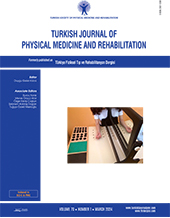Clinical and ultrasonographic enthesitis assessment before and after anti-tumor necrosis factor treatment in patients with spondyloarthritis
2 Department of Physical Medicine and Rehabilitation, Cerrahpaşa Medical Faculty, Istanbul University-Cerrahpasa, Istanbul, Türkiye
3 Department of Physical Medicine and Rehabilitation, Prof. Dr. Cemil Taşçıoğlu City Hospital, Istanbul, Türkiye DOI : 10.5606/tftrd.2024.11943 Objectives: This study aimed to clinically and ultrasonographically evaluate enthesitis in patients with spondyloarthritis (SpA) and to determine enthesitis response to anti-tumor necrosis factor (TNF) treatment.
Patients and methods: Thirty-one SpA patients (22 males, 9 females; mean age: 39.4±10.9 years; range, 22 to 60 years) who started anti-TNF treatment due to their high disease activity were included in the cross-sectional prospective study between May 2017 and January 2018. Ankylosing Spondylitis Disease Activity Score, Bath Ankylosing Spondylitis Disease Activity Index, Ankylosing Spondylitis Quality of Life Questionnaire, Bath Ankylosing Spondylitis Functional Index, and Bath Ankylosing Spondylitis Metrology Index were recorded. Maastricht Ankylosing Spondylitis Enthesitis Score (MASES) and Spondyloarthritis Research Consortium of Canada (SPARCC) Enthesitis Score were utilized for clinical enthesitis evaluation. Patients were ultrasonographically evaluated in accordance with the Madrid Sonographic Enthesitis Index (MASEI) by a blinded sonographer. Patients were clinically and ultrasonographically assessed at baseline and in the third month after the treatment.
Results: In the initial evaluation, 24 (77.42%) of the patients had clinical enthesitis, and 30 (96.77%) of the patients had ultrasonographic enthesitis. After anti-TNF treatment, MASES, SPARCC, MASEI-structure, MASEI-thickness, MASEI-bursitis, MASEI-Doppler, MASEI-inflammatory, and MASEI-total scores significantly decreased (p<0.05). There was no significant change in MASEI-damage, MASEI-erosion, and MASEI-calcification scores following the therapy (p>0.05).
Conclusion: Anti-TNF treatment may improve clinical and ultrasonographic enthesitis, particularly inflammatory changes. Erosions and calcifications may not ameliorate after three months of anti-TNF treatment.
Keywords : Anti-TNF, enthesitis, MASEI, spondyloarthritis, ultrasonography
















